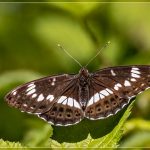In early November 2022 the Honshu white admiral butterfly, Limenitis glorifica was released at Travis Wetland for the first time.
Honshu butterflies are endemic to the island of Honshu, Japan and are used to help control Japanese honeysuckle (Lonicera japonica).
Japanese honeysuckle has the potential to become a serious pest weed in New Zealand.
Short fact sheets on Japanese honeysuckle from DOC and Landcare can be found here and here.
Japanese honeysuckle is difficult to control, we hope with the help of the Honshu butterfly we will be able to reduce the amount of herbicide used.
Honshu butterflies were first approved for use in NZ in August 2013, but the project had hit a few stumbling blocks along the way including the 2011 Japanese tsunami.
Eventually the problems were solved and they were first released in The Waikato and Auckland in 2014.
There is always a risk when introducing bio control agents that they will change host species and choose one of our natives.
Landcare Research has thoroughly tested this species and hasn’t found it to be a threat.
In fact it is pretty much a Japanese honeysuckle specialist, though they could be reared on Himalayan honeysuckle, which is another NZ invasive weed.
They were found to not be a threat to the common garden ornamental Lonicera nitida.
Identification:
The Honshu butterfly is quite distinctive, with no other butterflies in NZ resembling it.
It has a wingspan of around 60mm.
Blackish brown colouring with multiple white spots on the upper side, with silver and brown stripes with black spots on the underside of the wing.
Males and females are similar.
Life cycle:
An adult female is capable of laying up 200 pale yellow eggs on honeysuckle leaves over 2 – 4 weeks.
The eggs can hatch in a week with the egg to adult period being as short as 8 weeks and involving 5 instars.
Like most species of insect temperature plays an important part in development speed.
Adults can live for a month and multiple generations per season is possible if conditions are right.
Larvae are capable of overwintering.
We would like to thank Landcare Research for their generosity in supplying us with the brood stock of this butterfly.
While Travis doesn’t currently have a major problem with Japanese honeysuckle, it is well established in a couple of areas.
Hopefully our new friends will be able to help with the effective management of this invasive weed.
Keep a lookout for these butterflies on your wanders around Travis as they have already dispersed from their release site and have been seen on the track margins.
Info sources:
The Biological Control Of Weeds Book – Te Whakapau Taru: A New Zealand Guide, Landcare Research
https://oldwww.landcareresearch.co.nz/publications/newsletters/biological-control-of-weeds/issue-71/honshu-butterflies
and various other publications.
Article: Grahame
Images: John Skilton, Kenny Rose, Grahame






